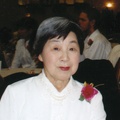This is a story told by Sachiko Masuoka about living through the atomic bombing of Hiroshima.
>> Part 1
That night (the 7th), mother came home late in the evening and told us about the death of my younger sister, who was 14 years old. She was at the school grounds for the opening ceremony at the nearby junior high. The school was near the epicenter. After the bright lightning flash (pika), the surroundings became dark. While one wondered what to do, the flash came again. At that time, everyone was around, so it was a relief that she did not die alone. But when the second flash happened, her clothes caught on fire. She desperately tried to extinguish the fire with her own hands. Her uniform was completely burned and the hand she used to extinguish the fire sustained a severe burn. The skin was just hanging. Mom found her body wearing only panties. Perhaps the ray hit her from the back, because her face sustained no burns. I was told she was beautiful.
Even in that condition, she went home. Of course, the house was completely destroyed. At that time we all carried what we called an emergency bag. In it we had the first aid kits, identification cards and other important documents. Everyone was required to carry it. The neighbor saw her and she was carrying that bag with the finger tip where her skin hung. Since her panties were burnt, she was too ashamed to walk home. She probably stayed where she was and died there.
My mother was transporting luggage for evacuation and she was pretty close to the epicenter. All her hair stood up at once. We have a saying that when you see something very frightening, your hair stands up. She had to use a bandage to keep her hair down. It started raining black drops and it became very cold.
My mother also hurried back to our house. When she was very near the house, the neighbor told her that my younger sister was standing by the shrine. So she turned and hurried back to the shrine and another neighbor told her that Yuri-chan was sitting in front of the shrine. She was so weakened that she could not stand. By the time my Mother got to the shrine, emergency personnel were loading her in the truck. Her entire body was burnt, so there is no place to grab. The only place that was not burned was under her arms, so the rescue people put their hands under her arms and mother put her hand on her bottom over her panties, and finally they were able to get her into the truck.
It was a miracle that my mother and my younger sister were able to meet each other in that chaos. If my mother got there a minute later, the truck would have left and my mother wouldn’t ever have been able to see her daughter forever again.
The two of them were carried to the auditorium of a school in the suburbs. That was the makeshift medical center. The people in the neighborhood donated clothing, futon and other things.
Many people were complaining of being cold but Yuri-chan never said cold and just slept. Once in a while, she opened her eyes and asked whether ofuro (bath) was ready. She probably wanted to take a bath and feel clean. She again opened her eyes and said she did not need to go home. She wanted to stay there. She probably had no energy or willpower to move. My mother asked if she was in pain. She answered that she was not. Perhaps her nerve ends were all dead, so she did not feel anything.
My mother was trying to take my sister’s shoes off, but they were not her shoes. The shoes were gone, her feet were all burnt and the skin was hanging loosely. The flesh was covered with sand and dirt and made it look as if she was wearing shoes. How was she able to walk in that condition? My heart ached and I cried when I heard this.
My sister had not eaten or drank anything since the morning, so my mother fed her a piece of canned mikan (mandarin orange). It was just a mouthful but Yuri-chan said it was delicious. That one piece of mikan was the last thing she ate in this world.
My mother helped others, feeding them and comforting them however she could, all night without any sleep.
The next morning around 6:00 a.m., mother told Yuri-chan that she was going to look for other family members. She nodded willingly, but fortunately before my mother left, my sister took her last breath. If it happened after she left, my mother would have felt so sad and regretful.
Mother thought that while my sister was sleeping, she was not feeling pain, so she tried not to disturb her. But if she had known that my sister was going to die so soon, she would have talked to her more. My mother was very regretful.
All the dead bodies, including my sister’s, were carried to the school grounds, made into a pile, sprayed with gasoline, and burned. (So many people died, one after another). There was no way my mother could have retrieved the bones, so she kept some hair and nails for a keepsake.
We looked for my younger brother, who was only six. We had no idea if he was able to escape with someone or if he was buried under the house. Even after a few days, what was left of the house was too hot to touch. We checked many emergency shelters, looking for him.
On the day we call the first seventh day, which is the one-week anniversary of a person’s death, we were hoping to find my brother, so we went out to search for him. We found his dead body on the roof. The body was burned to pure black. It seemed too big to be my brother but we approached closer. He was laying face down, so we got his body up and then saw a piece of cloth around his stomach. It was a part of his favorite shirt, which he was wearing that day. The size of the piece was only a half of my palm.
At that time we were not even able to conduct a funeral, so we found a piece of galvanized iron nearby and we laid him down on it. We picked up some wooden pieces from the house that were not burnt completely. We piled up those pieces and ignited them. Since his body was already burnt so badly, it did not take very long to cremate.
We did not have a container to keep his bones, so we looked for the ceramic store and found a small but pretty bowl with a lid. We picked that up and put his bones in it.
* This article was originally published in Voices of Chicago, online journal of the Chicago Japanese American Historical Society.
© 2010 Sachiko Masuoka





